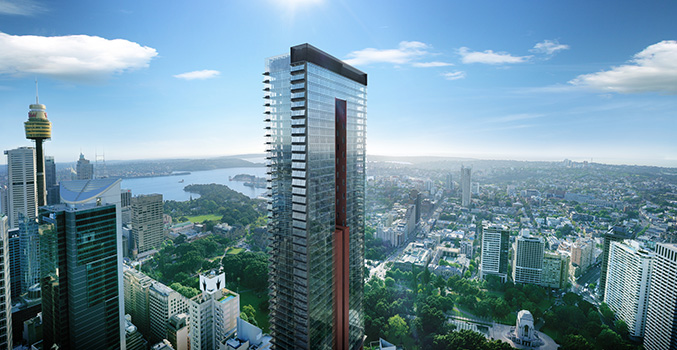The pandemic changed many aspects of Australian life. It gave us a crash course in working from home and some haven’t ventured back into the office, or at least not as often. The upshot has been a national rise in vacant office space. The overall office vacancy rate in Australian CBDs has increased from 12.8 to 13.5% in the last six months, according to Property Council of Australia figures released in February 2024. In non-CBD areas, it is almost 18%. That is a lot of vacant space in prime locations, areas generally well serviced by transport networks, close to employment hubs, and with good levels of amenity.
Office occupancy rates have persisted below pre-COVID levels for three years now. With many workplaces allowing more flexibility in working from home, office space requirements have shrunk. Even large organisations have compacted their operations as their leases have come up for post-COVID renewal. Every major Australian city has been left with a glut of vacant office space at a time when Australia is facing a housing supply crisis. With both home prices and rents at an all-time high, surely there is no better time to convert empty offices into homes. So why isn’t it happening? Let’s start by checking what’s happened historically.
Who is doing office conversions?
Firstly, converting offices into housing isn’t a new idea and it has been done in the past in Australia. Superannuation fund Australian Unity converted its former Melbourne headquarters in inner-city Albert Park into a 15-storey assisted living and aged care facility, unveiling it in 2023. More recently, it was announced the former Bank of China building in Sydney’s CBD is to be converted into a hotel, opening in late 2025. But it seems many Australian developers are loath to undertake such large-scale conversions due to high costs, limitations posed by older buildings, and regulations.
Globally, there has been much more activity. In the wake of COVID, cities around the world looked to unlock their disused office space to meet housing supply shortages. In the US, there are around 100 office-to-apartment conversion projects underway in major cities with another 200 planned or to be completed by the end of 2026, according to international commercial real estate company CBRE. It’s estimated the project pipeline will bring another 45,000 apartments onto the market. However, US real estate market analytics firm CoStar calculates the cost of converting an office building into ‘multifamily’ apartments averages about 20% more than starting a development from the ground up.
There has been a similar groundswell of office building conversions across Europe in the wake of the COVID pandemic. Germany is leading the way with projects underway in six of its major cities. Other European cities are also seeing developers test the water of the conversion market. But there are plenty of naysayers. Investment bank Goldman Sachs estimates office buildings need to undergo a 50% price drop for residential conversions to stack up financially. Meanwhile, one UK study found office buildings converted into homes under relaxed development regulations delivered significantly worse housing quality than homes approved under standard planning permission.
What are the problems of converting offices to housing?
Design limitations
Although office space is designed to be configured to meet the needs of commercial tenants, requirements of residential tenants are significantly different. Head of the School of Built Environment at the University of New South Wales Philip Oldfield (pictured below) agrees it makes sense to consider converting underutilised offices into housing, but there are significant challenges.
“Most fundamentally, many office buildings have design characteristics that don’t lend them to being converted to housing,” he told Savings.com.au.

Professor Philip Oldfield (Source: UNSW, Sydney)
“Office blocks tend to have large, ‘deep’ floorplans – perfect for open plan offices. But these can be very challenging to re-plan as apartments as their depth makes it difficult to ensure all rooms have access to natural light and cross ventilation.”
Indeed, residential buildings designed from scratch tend to have ‘shallower’ profiles with greater surface areas, essentially providing all apartments with windows. Simply dividing up many commercial office buildings into smaller lots can leave apartments at the core of the building without access to any windows at all – not an ideal outcome for future inhabitants.
Professor Oldfield said he’s been concerned particularly by the number of bedrooms he’s seen with no windows in office conversions taking place across the US – an outcome of converting deep office plans to housing. However, architects and engineers are working on solutions.
“For instance, exploring if we can structurally ‘cut’ pieces out of office floor plates to make it easier to plan apartments with access to light and air,” Professor Oldfield said.
One recent office building conversion in lower Manhattan saw developers cut holes in each floor to create two 19-storey courtyards in the centre of a building, providing internal natural light and ventilation.
Cost
But of course, such radical repurposing does not come cheap. On top of internal structural work, commercial buildings need to be retrofitted for basic amenities such as domestic electricity, plumbing, heating, air conditioning, telecommunications, and fire alarms for individual apartments. Each service can bring its own challenges and can be more difficult – and far more expensive – to install than for a ground-up development. The big key to keeping costs down is in identifying the right buildings to convert in the first place.
In the US, where office conversions are more commonplace, these buildings tend to be mid-rise, shallow structures with at least two sides of the building fronting open areas or streets, rather than being wedged in between other buildings that block light and air.
Closer to home, the Property Council of Australia engaged architecture group Hassell to identify suitable buildings in the Melbourne CBD that had the potential to be converted into homes. The study focused on buildings constructed before 1990 since they were more likely to require upgrades and were often of a “more suitable scale” for residential purposes. It nominated 86 buildings that would suit residential development.
Yet, Australian developers are hardly jumping into the market – and those who have are not creating affordable dwellings. The Greenland Centre (pictured below) in Sydney’s CBD, completed in 2021, saw the Chinese developer Greenland Group build another 41 storeys on top of the existing 26-storey Water Board building, originally built in the 1930s. All that remained of the original building was its steel structure. A three-bedroom apartment in the building was recently advertised with an expressions of interest price guide of $3.5 million.

Greenland Centre, Sydney (Source: Greenland Australia)
Professor Oldfield said most examples he has seen of office conversions in Australia tend to be high-end housing. “Cost-wide… [affordable housing conversions] require some public sector funding support, as costs to convert tend to be financially challenging for the private sector,” he said.
One of the big factors that rules out affordability in Australia is that most commercial office buildings tend to be in inner-city locations where land costs are high. The initial outlay for a building, even one that’s empty, can scuttle most projects even before conversion costs are tallied.
The benefits of office conversions
Reduce, reuse, recycle
Despite the drawbacks, the industry is alert to the environmental benefits of repurposing existing structures. Currently, in Australia, every new square metre of floor area carries around 500-1,000kg of carbon dioxide, referred to as embodied carbon. “If we adaptively reuse an existing building, if we are to retain the structure for example, that will save thousands of tonnes of concrete and steel and would likely reduce the embodied carbon by around 40%,” Professor Oldfield said. “Adaptive reuse is widely recognised as one of the most effective ways of reducing greenhouse gas emissions in the built environment.”
New York’s city authorities now have an Office Adaptive Reuse Task Force looking for opportunities to convert outdated office space for other uses, particularly housing. It’s aiming to facilitate the construction of 40,000 apartments from unused commercial buildings over the next 10 years.
The don’t make them like they used to
Another advantage is that older office buildings were designed to carry more weight. “Think big heavy photocopiers, filing cabinets, and more,” Professor Oldfield said. “If you convert them to housing, their structural requirements are reduced. This could mean there’s excess capacity in the structure which can allow new floors to be built on top of the existing building.” He gave the example of a 10-storey former office being converted into a 14-storey residential building, with the extra floors made of lightweight timber.
The UK experiment
In 2013, the United Kingdom government trialled a relaxed planning rules scheme, designed to encourage developers and builders to convert empty commercial spaces into housing. ‘Permitted development rights’ (PRD) was in response to mounting housing affordability and homelessness issues facing many of the country’s local councils. As at November 2023, the scheme had provided more than 81,000 homes, mostly in small-scale conversions of below 10 units.
A 2023 study of the scheme’s outcomes found high land costs, the unsuitability of many commercial buildings for residential adaption, and expensive conversion costs meant the asking price for properties overwhelmingly excluded low-income and first home buyers. In a bid to get the conversions to stack up financially, some developers targeted older buildings in less desirable locations such as edge-of-town industrial parks lacking amenities such as schools, medical services, and parks. The study cited examples of some English councils placing social tenants in hastily converted, isolated office blocks, variously labelled “open prisons”, “human warehouses”, and “slums of the future”.
After examining the outcomes of a decade of conversions under relaxed planning regulations, the study found councils lost the opportunity to secure affordable housing through developer contributions in return for planning permission. It also limited local councils' ability to ensure the commercial conversions best suited the needs of the localities.
So, are office space conversions feasible in Australia?
While A-grade office properties remain solidly leased in Australia’s CBD’s (albeit with incentives), property owners are struggling to find tenants for lower-grade commercial properties. As employers look to incentivise workers to return to the office, newer, prime office locations are continuing to lease at higher rates than ‘secondary’ commercial buildings. The Property Council of Australia noted the “clear divergence between older, low-quality stock and premium office buildings” in the latest vacancy data.
Urban Property Australia founder and managing director Sam Tamblyn said some landlords of B-, C-, and D-grade offices are already looking at converting under-occupied commercial buildings to residential apartments, possibly generating higher rental returns than they were from the offices. One option they are considering is the build-to-rent model that could be feasibly backed by institutional investors looking for assets generating long-term cash flow. But Australia is some way behind other countries in identifying adaptive reuse opportunities for its unloved buildings – and getting the projects off the ground.
Professor Oldfield believes the most efficient way to evaluate where conversions could work would be for councils to nominate suitable buildings. “The key to good adaptive reuse of office to housing is to find the right buildings – older offices that are perhaps smaller, or slender, are a good place to start,” he said.
Some government incentives might also be needed in getting the figures to stack up. Converting offices to homes could have some role to play in alleviating Australia’s current housing supply crisis but, according to Professor Oldfield, it is unlikely to be a big player. “There’s no silver bullet to solve the housing crisis, or the climate crisis. Adaptive reuse of office buildings would have benefits to both, but it’s only likely to play a small role in the future.”
Main image by Wolf Zimmermann on Unsplash
Additional images supplied by UNSW, Sydney and Greenland Australia

Ready, Set, Buy!
Learn everything you need to know about buying property – from choosing the right property and home loan, to the purchasing process, tips to save money and more!
With bonus Q&A sheet and Crossword!

